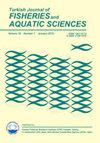大西洋鲣鱼对黑海鳀鱼的捕食效应及其可持续和最佳渔业
IF 1.7
4区 农林科学
Q3 FISHERIES
引用次数: 0
摘要
黑海南部的大西洋鲣鱼(Sarda sarda)和黑海鳀鱼(Engraulis encrasicolus)渔业目前缺乏一致的捕捞策略。为解决这一问题,开发了一个渔业模型,以优化和稳定这两个物种之间的捕食-被捕食关系。这项研究提供了一种优化和稳定的捕食者与被捕食者之间的关系,与研究中概述的当前捕捞策略相比,可提高上岸量和商业渔业利润。这项研究的结果可用于确定这些渔业的可持续产量和捕捞配额。此外,对这些物种之间捕食者与被捕食者关系的研究表明,大西洋鲣鱼年均消耗 93,259 吨凤尾鱼,约占估计平均凤尾鱼上岸量的 46%。此外,据观察,大西洋鲣鱼对鯷鱼的摄食量每增加或减少 10%,鯷鱼上岸量的波动可达 13%,鯷鱼利润的波动可达 40%。本文章由计算机程序翻译,如有差异,请以英文原文为准。
Predator Effect of Atlantic Bonito on the Black Sea Anchovy and Their Sustainable and Optimal Fishery
The Atlantic bonito (Sarda sarda) and Black Sea anchovy (Engraulis encrasicolus) fisheries in the southern part of the Black Sea currently lack a consistent harvesting strategy. To address this issue, a fishery model has been developed to optimize and stabilize the predator-prey relationship between these two species. This study offers an optimal and stable predator-prey relationship, resulting in higher landings and profits for the commercial fishery compared to the current harvesting strategy outlined in the study. The findings of this research can be utilized to determine sustainable yields and fishing quotas for these fisheries. Additionally, the examination of the predator-prey relationship between these species has revealed that, on an annual average, 93,259 tonnes of anchovy are consumed by the Atlantic bonito, which corresponds to approximately 46% of the estimated average anchovy landing. Furthermore, it has been observed that a 10% increase or decrease in the Atlantic bonito's feeding habits on the anchovy population leads to fluctuations in anchovy landings of up to 13% and anchovy profits of up to 40%.
求助全文
通过发布文献求助,成功后即可免费获取论文全文。
去求助
来源期刊

Turkish Journal of Fisheries and Aquatic Sciences
FISHERIES-MARINE & FRESHWATER BIOLOGY
CiteScore
3.10
自引率
0.00%
发文量
43
审稿时长
3 months
期刊介绍:
Turkish Journal of Fisheries and Aquatic Sciences" (TrJFAS) is a refereed academic journal has been published by Central Fisheries Research Institute of Turkey and Japan International Cooperation Agency (JICA), and published in English.
It aims to address research and needs of all working and studying within the many varied areas of fisheries and aquatic sciences.
The Journal publishes English language original research papers, critical review articles, short communications and technical notes on applied or scientific research relevant to freshwater, brackish and marine environments.
TrJFAS was published biannually (April & November) between 2001 and 2009. A great number of manuscripts have been submitted to the journal for review from acceptance of the SCI index. Thereby, the journal has been published quarterly (March, June, September and December) from 2010 to 2017. The journal will be published monthly in 2018.
 求助内容:
求助内容: 应助结果提醒方式:
应助结果提醒方式:


